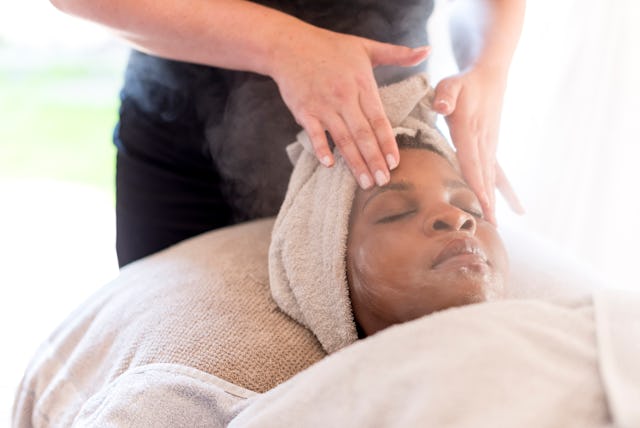How Often Should You Get A Facial? Here’s The Ideal Frequency, According To The Pros
Any more than this could be a waste of money.

Getting a facial is one of my favorite indulgences. I love having someone massage and cleanse my skin with creamy and sweet-smelling lotions and serums, and, of course, I love the results of my glowing complexion afterward. It's a blissful experience that I only allot myself a few times a year — which begs the question: How often should you get a facial? While I do walk out sporting a J. Lo glow, facials are typically a three-figure investment. So, is a shiny visage worth the money if regular facials are actually good for you?
"Facials are a luxury and not a necessity, but they offer us an opportunity to improve the texture of our skin in just one simple treatment," Dr. Loretta Ciraldo MD FAAD, a Miami-based board-certified dermatologist and founder of Dr. Loretta skincare, tells Scary Mommy. "Additionally, I've found from patient feedback during my 40 years of dermatology practice that a facial can also give us a nice psychological lift, and they can help with acne-prone skin."
So while facials might not be a total necessity, they can help your skin (and mind) in a number of ways. Here's what to know about facials and whether or not they are good for you or a waste of money.
What is a facial?
"Facials have traditionally been a multi-step facial treatment to clear pores and give skin a softer texture and glow. These traditional facials are performed by aestheticians and done in spas or salons," Ciraldo explains. "Now many dermatologists and med spas offer facials that vary from the traditional steam, pore extractions, and masks to include a light peel, sometimes called a lunchtime peel, done as part of a facial."
Rachael Gallo, esthetician and chief operating officer of Silver Mirror Facial Bar, adds that a facial is "a process in which an esthetician works to prevent the skin's natural changes related to age, hormones, eating habits, or climate. A facial can range from 30 minutes to two hours and can be customized to the guest's skin type, age, and even the level of relaxation required."
What does a facial do for your skin?
According to Ciraldo, a facial should help to improve your biggest skin challenges: "If you have acne-prone or oily skin, the facial should help to clean out your pores, lessen shiny appearance and surface oils, and even help to clear breakouts faster and prevent major new breakouts. For anti-aging, it will help to improve skin's luminosity, even skin tone as it brightens, and lessen the appearance of fine lines."
However, while all of those benefits are nice, Ciraldo cautions they can be short-lived if you don't supplement them with effective at-home skincare regimens. Additionally, there can be some drawbacks to facials as well. Some of the outcomes of a "bad" facial that Ciraldo has witnessed from her patients include:
- "If the facialist is too aggressive with extractions, you can get marks that can last from weeks to months."
- "If the facialist irritates your skin, you may get some hyperpigmentation if you are someone whose skin gets darker when irritated (like if you get a dark patch where you've burned your skin on a straightening iron or in the kitchen!)."
- "If you go to someone who either isn't experienced with inflamed acne and she opens up areas with pus, or if the facialist doesn't clean her devices well between clients, you may run a risk of the facial spreading some infection."
While a "bad" facial is certainly not the norm, it's important to mention that experiences like the ones above can happen, which is why it's key to vet your facialist.
How often should you have a facial?
Gallo recommends getting facials every four weeks. "It takes 28 days for our epidermis, the outermost layer of our skin, to die and flake off,” she says. “With regularly scheduled facials, we are able to ensure that we treat the new epidermal skin and restore your skin to its natural PH level."
Other factors can sometimes change this recommendation, such as if you're suffering from hormonal acne. "A pustule can start to form under the epidermis 10 days before we see it become a white head. In these cases, we would recommend facials every two weeks to speed up the removal of the dead epidermis skin and treat the acne before it clogs the pore,” Gallo elaborates.
However, as Ciraldo points out, facials can be expensive, "so please remember that you should never feel you have to have one or that you are taking good care of your skin if you don't see a facialist."
How can one replicate a facial while at home?
If your budget doesn't allow for a regular facial, don't sweat — Gallo says skincare is all about the right ingredients to treat your skin type and or condition. "You can replicate some of the facial steps at home, such as cleansing, exfoliating, massaging, and using treatment masks, as long as they are using the right ingredients," she explains.
For example, if you have dry skin, she recommends looking for ingredients such as hyaluronic acid or cucumber extract. "Mixing natural ingredients with your favorite skin care lines can help you enjoy a relaxing at-home spa day,” she explains, adding the caveat, “We recommend leaving some of the more skilled facial techniques, such as extractions, dermaplaning, and chemical peels, to your licensed esthetician."